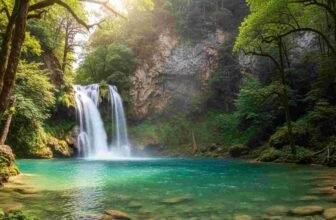
There’s something magical about standing on a trail, the air crisp and alive, surrounded by the kind of beauty that takes your breath away.
It’s not just a hike; it’s a journey that reminds you of how small you are—and how vast the world is. The thrill of the climb, the awe of nature’s untouched masterpieces, and that quiet moment when everything feels still—it’s unforgettable.
Whether you crave adventure or a serene escape, these trails aren’t just paths; they’re gateways to experiences that linger in your soul. Ready to uncover views that will change how you see the world? Let’s begin.
1. Grand Canyon Rim-to-Rim Trail, Arizona

There’s something utterly transformative about hiking the Rim-to-Rim Trail in the Grand Canyon. This iconic trek spans approximately 24 miles and takes you from the North Rim to the South Rim, offering views that are simply unmatched. Along the way, you’ll encounter lush oases like Phantom Ranch, towering canyon walls, and stunning vistas that seem to stretch endlessly. It’s not just a hike; it’s an experience that stays with you forever.
I remember my first attempt on this trail—about halfway through, I hit “the wall” at Bright Angel Creek. But then, the surreal beauty of the inner canyon pushed me forward. You’ll need to pace yourself, as the elevation changes and desert heat can be grueling, but the sense of accomplishment at the end is worth every step.
The trail is physically demanding, but it also brings you face-to-face with the raw power of nature. From the early morning light spilling over the canyon walls to the cool shadows as the sun dips below the rim, every moment feels like a snapshot from a dream.
Relevant Information:
- The best Months to Visit: are May and October (milder temperatures).
- Trail Length: 24 miles one-way.
- Difficulty Level: Strenuous.
- Permits Required: Yes, for overnight camping.
- Key Highlights: Phantom Ranch, Bright Angel Creek, North Kaibab Trail.
2. Half Dome Trail, Yosemite National Park, California

Standing atop Half Dome in Yosemite National Park feels like you’ve conquered a small slice of the world. This 14-16 mile round-trip hike combines steep ascents with awe-inspiring views of Yosemite Valley, Vernal Falls, and Nevada Falls. The infamous cables leading to the summit? A thrill like no other.
My first time on the cables was equal parts exhilarating and nerve-wracking. The adrenaline coursing through you as you hold on tight, inching your way up, makes the view at the top even sweeter. Reaching the summit feels like earning a personal victory, as you gaze out over the valley below.
What makes this trail special isn’t just the final ascent—it’s the journey. The cascading waterfalls, serene forests, and rocky switchbacks make every mile worthwhile. It’s a testament to Yosemite’s grandeur, blending challenge with raw beauty.
Relevant Information:
- Best Months to Visit: Late May to September (when the cables are up).
- Trail Length: 14-16 miles round-trip.
- Difficulty Level: Very strenuous.
- Permits Required: Yes, via a lottery system.
- Key Highlights: Vernal Falls, Nevada Falls, Half Dome cables.
3. Appalachian Trail – Smoky Mountains Portion, Tennessee/North Carolina

The Smoky Mountains portion of the Appalachian Trail is a perfect blend of natural beauty and cultural heritage. Stretching about 70 miles, this section offers panoramic views, ancient forests, and a taste of one of the world’s longest hiking trails. Highlights include Clingman Dome, the highest point on the Appalachian Trail.
I hiked part of this trail during peak fall foliage, and the colors were nothing short of breathtaking. The golden reds and yellows of the trees felt like walking through a painting. Plus, the rich history of the Smokies—home to diverse wildlife and remnants of old Appalachian homesteads—adds depth to the experience.
Whether you’re a seasoned thru-hiker or someone tackling a day hike, this portion of the trail offers something for everyone. The cool mountain air and the sounds of chirping birds make it a refreshing escape from everyday life.
Relevant Information:
- Best Months to Visit: April-May and September-October (spring blooms and fall foliage).
- Trail Length: 70 miles (can do shorter portions).
- Difficulty Level: Moderate to strenuous.
- Permits Required: Yes, for camping in the park.
- Key Highlights: Clingmans Dome, Charlie Bunion, Spence Field.
4. Kalalau Trail, Kauai, Hawaii

Hiking the Kalalau Trail on Kauai’s Na Pali Coast is like stepping into a postcard. This 11-mile trail (one-way) hugs the coastline, offering jaw-dropping views of turquoise waters, lush cliffs, and golden beaches. The final destination, Kalalau Beach, feels like a hidden paradise.
My trip on this trail was a mix of awe and adventure. Tropical rain showers added a slick challenge to the trail, but the vibrant rainbows that followed made it all worthwhile. The trail is demanding but rewarding, especially as you approach Hanakapiai Falls or peer down into the verdant valleys below.
With its dramatic cliffs and serene beaches, this trail embodies Hawaii’s wild beauty. Just remember to prepare for muddy conditions and pack plenty of water—this is not a hike you can rush through.
Relevant Information:
- Best Months to Visit: May to September (drier season).
- Trail Length: 22 miles round-trip.
- Difficulty Level: Strenuous.
- Permits Required: Yes, for camping at Kalalau Beach.
- Key Highlights: Na Pali cliffs, Hanakapiai Falls, Kalalau Beach.
5. Angels Landing, Zion National Park, Utah

If you’re looking for a hike that’s as thrilling as it is scenic, Angels Landing in Zion National Park is your answer. This 5.4-mile round-trip trail is famous for its dizzying heights and heart-pounding chain sections. The views from the top? Worth the adrenaline rush.
My palms were sweaty the first time I gripped the chains on the final ascent. But the sense of camaraderie among hikers and the panoramic views of Zion Canyon made it an unforgettable adventure. It’s not for the faint of heart, but if you’re up for the challenge, Angels Landing rewards you tenfold.
This trail is a Zion classic, offering a unique mix of thrills and natural beauty. It’s a hike that demands respect—both for the trail’s difficulty and for its stunning vistas.
Relevant Information:
- Best Months to Visit: March-May and September-November (mild weather).
- Trail Length: 5.4 miles round-trip.
- Difficulty Level: Strenuous and exposed.
- Permits Required: Yes, via a lottery system.
- Key Highlights: Scout Lookout, chain section, Zion Canyon views.
6. The Wave Trail, Coyote Buttes, Arizona/Utah

Hiking to The Wave feels like entering another dimension. This 6.4-mile round-trip hike is famous for its surreal, wave-like sandstone formations. Located in the Paria Canyon-Vermilion Cliffs Wilderness, this trail is a bucket-list hike for its unique geological wonders and mesmerizing colors.
My journey here was a true adventure. With limited permits issued daily, securing a spot felt like winning the lottery. The trail itself is not marked, so navigating with GPS is essential, but the unfolding views make every effort worth it. When I finally arrived at The Wave, the sight was unlike anything I had ever experienced—swirling sandstone in reds, yellows, and oranges under a vast blue sky.
While the trail isn’t overly long, it requires stamina due to the sandy terrain and exposure to the elements. Pack plenty of water, and don’t forget a camera to capture this natural masterpiece.
Relevant Information:
- Best Months to Visit: March to May and September to November (avoid extreme heat).
- Trail Length: 6.4 miles round-trip.
- Difficulty Level: Moderate.
- Permits Required: Yes, through an online or walk-in lottery system.
- Key Highlights: The Wave Formation, Paria Canyon, Vermilion Cliffs.
7. Wonderland Trail, Mount Rainier National Park, Washington

Circling the majestic Mount Rainier, the Wonderland Trail is a 93-mile loop that’s nothing short of epic. Known for its challenging terrain and jaw-dropping views, the trail offers alpine meadows, glacier vistas, and dense forests. It’s a backpacker’s dream.
I tackled a segment of this trail during a summer trip, and even that brief taste left me speechless. The wildflower-filled meadows at Summerland looked like something out of a fairy tale, while the sight of Rainier’s glaciers glinting in the sun was unforgettable. The sense of isolation here is perfect for escaping the rush of daily life.
While the full loop requires about 10 days, even shorter sections provide a glimpse into the rugged beauty of the Pacific Northwest. Be prepared for unpredictable weather and steep elevation gains—this trail is as demanding as it is rewarding.
Relevant Information:
- The best Months to Visit: are July to September (when the snow has melted).
- Trail Length: 93 miles (can hike segments).
- Difficulty Level: Strenuous.
- Permits Required: Yes, for overnight stays.
- Key Highlights: Glacier views, Summerland, Panhandle Gap, Reflection Lakes.
8. Bright Angel Trail, Grand Canyon National Park, Arizona

The Bright Angel Trail is a classic Grand Canyon hike that combines accessibility with stunning views. Spanning 9.5 miles one way from the South Rim to the Colorado River, it’s a popular choice for hikers seeking a challenging but manageable canyon experience.
On my hike, I was amazed by how the trail changes as you descend. From towering red cliffs to lush greenery near Indian Garden, each mile reveals something new. The ascent back to the rim, however, is no joke—prepare for a serious workout.
This trail is perfect for those wanting a taste of the canyon without committing to the full Rim-to-Rim experience. It’s well-maintained, with plenty of rest stops and water stations, making it an excellent option for hikers of various skill levels.
Relevant Information:
- Best Months to Visit: Spring and fall (cooler temperatures).
- Trail Length: 9.5 miles one-way.
- Difficulty Level: Moderate to strenuous.
- Permits Required: Yes, for overnight camping.
- Key Highlights: Indian Garden, Plateau Point, Colorado River.
9. Harding Icefield Trail, Kenai Fjords National Park, Alaska

If you’ve ever dreamed of walking alongside a glacier, the Harding Icefield Trail is your chance. This 8.2-mile round-trip trail offers incredible views of the Exit Glacier and culminates in a jaw-dropping panorama of the Harding Icefield—a vast sheet of ice that stretches as far as the eye can see.
Hiking this trail felt like stepping into another world. The air was crisp, and the sight of icebergs calving into glacial streams was surreal. Reaching the summit rewarded me with a silence that felt almost sacred, broken only by the occasional crack of the ice below.
This trail is steep and challenging, but the experience is unforgettable. Make sure to dress in layers, as the weather can change rapidly, and carry bear spray—this is prime bear country.
Relevant Information:
- Best Months to Visit: June to September (snow-free conditions).
- Trail Length: 8.2 miles round-trip.
- Difficulty Level: Strenuous.
- Permits Required: None for day hikes.
- Key Highlights: Exit Glacier, Harding Icefield views, alpine meadows.
10. The Narrows, Zion National Park, Utah

The Narrows is less of a trail and more of an experience. This 16-mile hike through the Virgin River takes you deep into a canyon, with towering sandstone walls on either side and cool water underfoot. It’s one of Zion’s most famous and unique adventures.
I’ll never forget the feeling of wading through knee-deep water, surrounded by rock walls that seemed to touch the sky. The sound of the rushing river and the play of light on the canyon walls create a magical atmosphere. The hike can be tailored to your preferences—go as far as you like and turn back when you’re ready.
This trail is perfect for adventurous souls who don’t mind getting wet. Proper footwear and a dry bag are must-haves, and always check water levels before setting out—safety first!
Relevant Information:
- Best Months to Visit: Late spring to early fall (low water levels).
- Trail Length: 16 miles round-trip (or shorter sections).
- Difficulty Level: Moderate.
- Permits Required: Yes, for top-down hikes.
- Key Highlights: Wall Street section, Virgin River, towering sandstone cliffs.
11. Presidential Traverse, White Mountains, New Hampshire

The Presidential Traverse is a rite of passage for serious hikers. This grueling 23-mile hike traverses the peaks of the Presidential Range, including Mount Washington, the highest peak in the northeastern United States. It’s a challenge that combines steep climbs, rocky ridges, and views that feel almost otherworldly.
When I tackled this trail, I was struck by the variety of landscapes—from dense forests to open alpine tundra. Each peak felt like its own reward, with sweeping vistas stretching across New Hampshire and beyond. The weather can change in an instant here, adding an element of unpredictability that keeps you on your toes.
This hike isn’t for the faint-hearted. It demands preparation, stamina, and respect for nature’s power. But for those willing to take it on, the Presidential Traverse offers an unforgettable adventure in one of the country’s most dramatic mountain ranges.
Relevant Information:
- Best Months to Visit: Late June to September (to avoid snow and storms).
- Trail Length: 23 miles one-way.
- Difficulty Level: Very strenuous.
- Permits Required: None for day hikes.
- Key Highlights: Mount Washington, Mount Adams, alpine ridges.
12. Mist Trail, Yosemite National Park, California

The Mist Trail is one of Yosemite’s crown jewels. This 7-mile round-trip hike takes you past two of the park’s most iconic waterfalls: Vernal Falls and Nevada Falls. As the name suggests, you’ll likely be misted (or soaked) as you climb the steep granite steps alongside the cascading waters.
There’s a certain joy in getting drenched by the cool spray of Vernal Falls on a hot summer day. The sight of the rainbow forming in the mist is pure magic. The trail’s steepness demands some effort, but the views at the top of Nevada Falls are a worthy payoff, with Yosemite’s rugged beauty on full display.
This trail is perfect for those who want a mix of challenge and accessibility. While the steps can be slippery, the experience of being so close to these powerful waterfalls makes every step worthwhile.
Relevant Information:
- Best Months to Visit: May to July (waterfalls at their fullest).
- Trail Length: 7 miles round-trip.
- Difficulty Level: Moderate to strenuous.
- Permits Required: None for day hikes.
- Key Highlights: Vernal Falls, Nevada Falls, Emerald Pool.
13. Maroon Bells-Snowmass Trail, Colorado

Nestled in the heart of the Rockies, the Maroon Bells-Snowmass Trail is a 26-mile loop that showcases Colorado’s alpine splendor. From reflective mountain lakes to fields of wildflowers and snow-capped peaks, this trail is a photographer’s dream and a hiker’s paradise.
I hiked this trail in late summer, and the sight of the Maroon Bells mirrored in the crystal-clear lake at sunrise was unforgettable. The air was crisp, and the only sounds were the chirping birds and rustling leaves. It’s a trail that rewards you with solitude and serenity, even as it challenges you with its elevation gains.
Though demanding, this loop offers some of the most stunning landscapes in the Rockies. It’s a chance to immerse yourself in nature and feel a sense of awe at the grandeur of the mountains.
Relevant Information:
- Best Months to Visit: July to September (snow-free trails).
- Trail Length: 26 miles loop.
- Difficulty Level: Strenuous.
- Permits Required: Yes, for overnight camping.
- Key Highlights: Maroon Lake, alpine meadows, snow-capped peaks.
14. Cascade Canyon Trail, Grand Teton National Park, Wyoming

If there’s one hike that encapsulates the majesty of the Tetons, it’s the Cascade Canyon Trail. This 9-mile round-trip hike (or longer if you continue) offers breathtaking views of rugged peaks, serene lakes, and vibrant wildflowers.
I remember how peaceful this trail felt, with the towering Grand Teton peaks framing every step. Moose sightings in the meadows and the sound of rushing streams added to the sense of wilderness. The hike to Hidden Falls and Inspiration Point is a favorite for its accessibility and beauty.
Cascade Canyon is a trail for all kinds of hikers, whether you’re after a gentle day hike or an ambitious trek. The scenery is constantly changing, keeping you captivated from start to finish.
Relevant Information:
- Best Months to Visit: June to September (when snow has melted).
- Trail Length: 9 miles round-trip to Inspiration Point.
- Difficulty Level: Moderate.
- Permits Required: None for day hikes.
- Key Highlights: Hidden Falls, Inspiration Point, wildlife sightings.
15. Devil’s Garden Trail, Arches National Park, Utah

The Devil’s Garden Trail is a treasure trove of natural wonders. This 7.9-mile loop weaves through a landscape filled with sandstone arches, spires, and fins. It’s an exploration of the desert’s artistry, with highlights like Landscape Arch, Double O Arch, and the challenging Primitive Loop.
Walking this trail felt like stepping into another world. The delicate balance of the thin, ribbon-like Landscape Arch and the rugged beauty of the Double O Arch left me in awe. The Primitive Loop added an extra sense of adventure, with narrow ledges and rocky scrambles.
This trail offers something for everyone, from casual hikers to thrill-seekers. The ever-changing colors of the sandstone and the quiet desert atmosphere make it a hike to remember.
Relevant Information:
- Best Months to Visit: March to May and September to November (avoid extreme heat).
- Trail Length: 7.9 miles loop.
- Difficulty Level: Moderate to strenuous.
- Permits Required: None.
- Key Highlights: Landscape Arch, Double O Arch, Primitive Loop.






